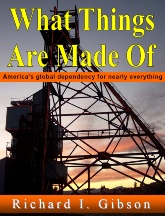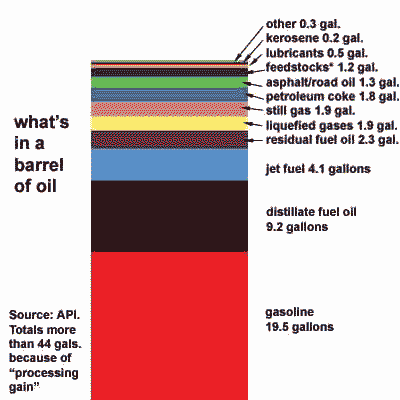
Some interesting oil industry statistics - gasoline
©1997-2009 Gibson Consulting

 | By Richard Gibson:
What Things Are Made Of
The story of America's dependency
on mineral commodities (including oil) in everyday life.
Buy the book. Print (312 pages): $17.95; electronic (PDF) $9.99. Additional e-versions details to come.
visit the blog | Share this article
|
Support this page! |
US Gasoline consumption (2008):
The most recent figures available are for August - (here) - when the US consumed about 9.1 million barrels of gasoline per day (this excludes diesel and other fuels). That amounts to 9.1 x 42 = 382,000,000 gallons per day x 7 = 2,675,000,000 (2.7 billion) gallons per week. This is a decline from a high of about 9.3 million barrels per day of gasoline in 2006-2007.
Q: I am looking for a flow sheet describing the processes, expenses and end
products of oil refining. For example, take one barrel of crude, and what comes
out of it in what process?
IIRC a barrel is 33 or so gallons, so out of that 33 gallons, how many gallons
of regular unleaded, mixed grade, premium, diesel, motor oil, napatha, etc,
etc? What is the average cost to produce these, per item such as gasoline,
motor oil, diesel, etc.? If the numbers are only available in barrels or
thousand gallon lots, no problem.
A: NOT 33 gallons -- 42 gallons per barrel makes about 19½ gallons of gasoline, 9 gallons of fuel oil, 4 gallons of jet fuel, and 11 gallons of other products, including lubricants, kerosene, asphalt, and petrochemical feedstocks to make plastics. That adds up to more than 42 gallons because of something called "refinery gain" - the processing and chemical changes increase the volume.
 Q: How many (US)
gallons of 87 octane gasoline can be made from one barrel of crude oil?
Q: How many (US)
gallons of 87 octane gasoline can be made from one barrel of crude oil?
A: 19.5
Q: How
much does the average gas station pay to buy a gallon of gasoline from an oil
company?
A: Retailer (gas station) profit is about 1 to 5 cents a gallon. So they pay the posted price, less that and less taxes (federal, state, local).
Q: I did some simple calculations, and the numbers don't seem to make any sense.
Let's assume that the price of crude oil is $37.00 per barrel. At 19.5 gallons
of gasoline per barrel, this means that a gallon of gasoline in its crude oil
form costs $1.90. Yet, when I pump it into my car, I'm currently paying $1.76
per gallon. This means that the gasoline is losing 14 cents per gallon in value
when going from ground to gas pump. This must mean that everyone involved in
transporting and refining the oil and gasoline must be marking down the final
price of their finished product. Companies mark up, not down. Obviously, there
is something wrong here somewhere.
A: The 42-gallon barrel of crude oil makes about 19½ gallons of gasoline,
9 gallons of fuel oil, 4 gallons of jet fuel, and 11 gallons of other products,
including lubricants, kerosene, asphalt, and petrochemical feedstocks to make
plastics. [See also this EIA page] That adds up to more than 42 gallons because of something called "refinery
gain" - the processing and chemical changes decrease the density and hence increase the volume of the refined components. So, crudely (pun intended), a $37 barrel
of crude represents about 88 cents a gallon to start with. That 88c represents
the cost of production plus producer profit. Go up from there.
Numbers that I found some time ago had this for other increments of the cost per gallon:
refiner cost - 13c
marketing cost - 5c
transportation cost - 15c
retailer cost - 5c
refiner, marketer, transporter, retailer profit - 10c (total, not each)
Add that to 88c, add the average 43 cents tax, and -- rather remarkably -
that adds up to $1.79, if I added correctly - just about what you are paying.
All the numbers vary depending on a long list of things -- refiner costs go
up when they have to make specialized local blends (one reason for CA and Chicago
having higher prices), marketing costs are higher in competitive markets (i.e.,
big cities), transportation costs are higher in the boondocks, or generally
in places distant from refineries, retailer costs depend on number of employees,
whether or not it is a franchise (some rural stations that I know of here in
Montana have to pay many thousands of dollars per year for the "right" to be
branded Conoco, or whatever); and the total price also depends on differing
state and local taxes. So these numbers would be ball-park, approximations.
2006 Question: Why is the price of gasoline not even higher than it is, given that the price of crude is around $63 per barrel, close to double the price of a couple years ago? Answer: I truly don't know - evidently the forces driving the price of gasoline are beyond me. I'm amazed that the price of gasoline is not much higher than it is. • Link showing price breakdown in California
See also EIA Primer on Gasoline Prices. Other links: this
article and this GAO report
and This
One and another. And Gas Q&A.
Compiled by Dick Gibson, Gibson Consulting, 301 N. Crystal St., Butte, MT 59701
Want to know more?
Gibson Consulting recommends: Read The Prize, by Daniel Yergin. |


©1997-2009 Gibson Consulting
Background image of drilling well in Utah in 1981 © 2000 by Dick Gibson



 Q: How many (US)
gallons of 87 octane gasoline can be made from one barrel of crude oil?
Q: How many (US)
gallons of 87 octane gasoline can be made from one barrel of crude oil?